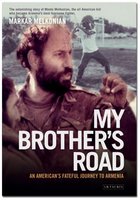Book Review by Paul Chaderjian
 My Brother's Road
My Brother's Roadby Markar Melkonian with Seta Melkonian
By any account, the enigmatic genius, scholar, political activist, soldier and freedom fighter Monte Melkonian led a short-lived but extraordinary life. In the newly published My Brother’s Road, Monte’s brother Markar, with the help of Monte’s widow Seta, chronicles one Californian’s journey from small town kid to legendary martyr.
Monte’s modern-day epic begins in 1969, when the Melkonians visit their maternal grandmother’s ancestral village in Western Armenia, some 55 years after the Genocide. At the impressionable age of eleven, Monte sees his grandmother’s birthplace, watches the Turks who have taken up residence in the village, notices the Armenian Church has become a Turkish movie theatre and ponders about the outlines left when crosses were chiseled off doors.
His people had disappeared from the village and the region, millions of Armenians had evaporated from the face of the planet, and the Turks still denied they had done anything wrong. This great riddle and his family’s visit to the ‘old country’ shape Monte’s eventual mission to seek justice for the crimes against his people.
Monte’s humanitarian concern develops further at Mt. Whitney High School in Visalia, California. In 1973 at the age of 15, Monte — the “mentally gifted minor” bored with his high school courses —is invited to spend three months in Japan as a sister city representative from Visalia to Miki City near Osaka.
After the visit, Monte decides to stay with some friends in Japan, to earn money teaching English and then to travel through Southeast Asia on his own. These travels raise his awareness of peoples struggles for self-determination and independence.
During his studies at UC Berkeley, Monte becomes feverish about righting the wrongs done to the Armenians. He decides to bypass doctoral studies at Oxford and commits himself selflessly for the Armenian independence movement in the early 1980’s.
Monte’s mission for justice takes him to the suburbs of Beirut, Tehran, and Paris where his activities eventually land him in a European jail cell. These chapters of his life read like a fictional Hollywood account of a hero or anti-hero’s intriguing involvement with secret armies, assassination plots and lessons learned to make possible his victories on the battlefield of Karapagh at the end of his life.
When Perastroika and Glastnost present the opportunity for Monte’s people to declare their independence from the USSR, the modern day freedom fighter’s focus shifts from Western Armenia to Karapagh, where Armenians are the victims of barbaric pogroms and Armenian children are burnt on kitchen stoves, reminiscent of the atrocities suffered by his grandmother’s family and others like them during the Armenian Genocide of 1915.
During the early 1990s, when Armenians are hungry, landlocked, facing an economic and energy blockade, defenseless, cold and abandoned by the world, Monte and other like him from the Diaspora reach back to the homeland from all obscure corners of the world. The sons and daughters of the Diaspora, the grandchildren of Genocide survivors return to their ancestral homeland to turn their people from victims to victors.
My Brother’s Road is an intriguing look into the psychology of a man who left ‘the good life’ behind in the bountiful San Joaquin Valley of Central California to stand up for those oppressed overseas. It is both an educational and historical atlas of the road traveled not just by one man but by a people struggling for cultural preservation and freedom near the end of the 20th century.
Written by Paul Chaderjian Reporting for Mosaix Magazine ©2004
No comments:
Post a Comment